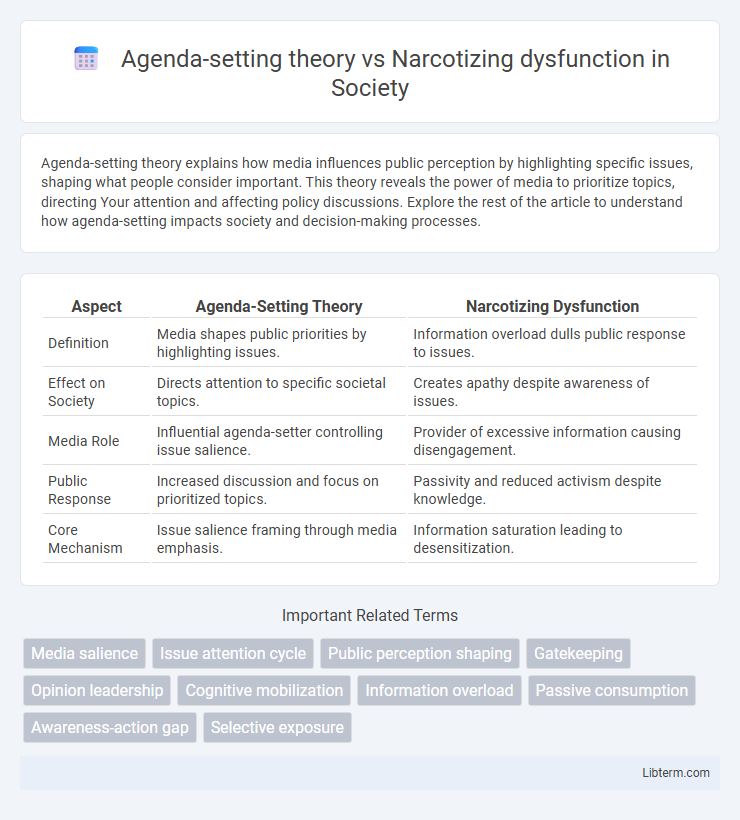Agenda-setting theory explains how media influences public perception by highlighting specific issues, shaping what people consider important. This theory reveals the power of media to prioritize topics, directing Your attention and affecting policy discussions. Explore the rest of the article to understand how agenda-setting impacts society and decision-making processes.
Table of Comparison
| Aspect | Agenda-Setting Theory | Narcotizing Dysfunction |
|---|---|---|
| Definition | Media shapes public priorities by highlighting issues. | Information overload dulls public response to issues. |
| Effect on Society | Directs attention to specific societal topics. | Creates apathy despite awareness of issues. |
| Media Role | Influential agenda-setter controlling issue salience. | Provider of excessive information causing disengagement. |
| Public Response | Increased discussion and focus on prioritized topics. | Passivity and reduced activism despite knowledge. |
| Core Mechanism | Issue salience framing through media emphasis. | Information saturation leading to desensitization. |
Introduction to Agenda-Setting Theory and Narcotizing Dysfunction
Agenda-setting theory explains how media shapes public perception by prioritizing certain topics, influencing what audiences consider important. Narcotizing dysfunction describes a phenomenon where excessive media exposure causes audience apathy, leading to passive consumption rather than active engagement. Both concepts address media effects but highlight contrasting impacts on public awareness and civic participation.
Historical Background of Both Media Theories
Agenda-setting theory emerged in the 1970s through the research of Maxwell McCombs and Donald Shaw, who explored how media influence public perception by highlighting certain issues, establishing a foundational concept in communication studies. Narcotizing dysfunction, introduced by Paul Lazarsfeld and Robert K. Merton in the 1940s, critiques mass media's role in creating apathy by overwhelming audiences with information, leading to passive consumption rather than active engagement. Both theories reflect evolving concerns about media effects during periods of increasing mass communication and societal change.
Defining Agenda-Setting Theory
Agenda-setting theory explains how media influence public perception by prioritizing certain topics, shaping what audiences consider important. It highlights the media's role in emphasizing specific issues, thereby guiding the public's attention and discussion. This contrasts with narcotizing dysfunction, where overexposure to information leads to public apathy rather than engagement.
Explaining Narcotizing Dysfunction
Narcotizing dysfunction refers to the phenomenon where excessive media exposure leads to public apathy rather than action, causing individuals to become passive consumers of information instead of actively engaging with social or political issues. Unlike Agenda-setting theory, which emphasizes the media's power to shape public priorities by highlighting specific topics, narcotizing dysfunction highlights how media oversaturation can numb citizens to important issues, reducing the likelihood of real-world activism. This concept underscores the paradox that increased information availability can result in decreased civic participation and social responsiveness.
Core Assumptions and Mechanisms
Agenda-setting theory assumes media shapes public perception by highlighting specific issues, influencing the importance audiences assign to topics through repeated coverage and framing. Narcotizing dysfunction suggests media saturation leads to audience apathy, where excessive information causes disengagement and confusion, diminishing active participation. While agenda-setting emphasizes media's role in prioritizing issues, narcotizing dysfunction highlights the paradox of awareness coupled with passivity in audience response.
Effects on Public Opinion and Audience Behavior
Agenda-setting theory emphasizes how media prioritization shapes public opinion by highlighting specific issues, guiding audience attention and concern toward those topics. Narcotizing dysfunction describes the media's paradoxical effect, where overwhelming information exposure leads to audience apathy and passive consumption, reducing active engagement despite awareness. Both theories illustrate critical but contrasting impacts on audience behavior: agenda-setting energizes issue focus, while narcotizing dysfunction dilutes action by saturating viewers with information.
Differences Between Agenda-Setting and Narcotizing Dysfunction
Agenda-setting theory explains how media influences public perception by highlighting specific issues, shaping what audiences think about and prioritize. Narcotizing dysfunction describes the media's effect of overwhelming people with information, leading to apathy and inaction despite awareness of issues. The key difference lies in agenda-setting fostering issue salience and engagement, while narcotizing dysfunction results in knowledge saturation but diminished public participation.
Real-World Examples and Case Studies
Agenda-setting theory is exemplified by how major news outlets shaped public opinion during the 2020 U.S. presidential election, prioritizing issues like the economy and healthcare to influence voter focus. Narcotizing dysfunction is evident in social media trends where overwhelming information on climate change activism led to passive consumption rather than active participation, as seen in the 2019 global climate strikes. Both concepts demonstrate media's powerful but contrasting effects on public engagement and attention in democratic societies.
Criticisms and Limitations of Each Theory
Agenda-setting theory faces criticism for its limited explanation of media effects, often overlooking individual differences in audience interpretation and the role of new digital media platforms in shaping public attention. Narcotizing dysfunction is criticized for its overly pessimistic view of media consumption, ignoring how active engagement with media content can lead to social mobilization rather than apathy. Both theories struggle with empirical measurement challenges and may oversimplify the complex relationship between media, cognition, and social behavior.
Conclusion: Implications for Modern Media Consumption
Agenda-setting theory reveals how media shapes public priorities by highlighting specific issues, guiding audience perception and discourse. Narcotizing dysfunction suggests media saturation can overwhelm individuals, leading to apathy despite increased information exposure. Modern media consumption must balance informative agenda-setting with strategies to prevent disengagement caused by excessive content saturation.
Agenda-setting theory Infographic

 libterm.com
libterm.com